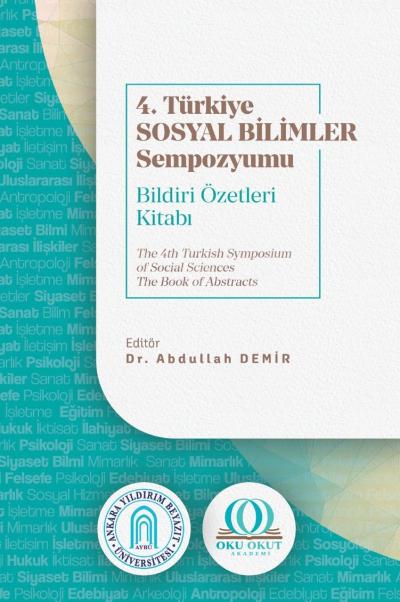Oku Okut Press reserves the right to publish and distribute the book. Permission from the publisher is required for any commercial use.
Instruments of Perception and in Ḥakīm al-Tirmidhī’s Bayān al-fark His Approach to Ishārī Tafsir
Hakîm et-Tirmizî’nin Beyânü’l-fark Eserinde İdrak Araçları ve İşârî Yorum İlişkisi
Authors
This paper analyses the relationship between the means of perception and ishārī interpretation in al-Ḥakīm al-Tirmidhī's (d. 320/930) Bayān al-Farq. It is seen that al-Tirmidhī wrote this work within the framework of the issue of ‘How should the Qur'an be understood?’, which is one of the basic questions discussed in the formation process of Sufism. The author develops a different perspective on the subject in the history of Sufism by quoting verses from the Qur'an and associating the means of perception that he explains on the axis of the concept of “qalb” with Isārī interpretation. In this paper, the work is analysed through textual analysis within the framework of the question of what al-Tirmidhī aims with the connection between the levels of perception and Isārī interpretation, and al-Tirmidhī's theoretical approaches on this subject are evaluated. As a result of the textual analysis, the idea that the place of the science of signs and wisdom is the “qalb” comes to the fore in the connection that al-Tirmidhī establishes between the levels of perception and Isārī interpretation. The qalb as an instrument of perception and its degrees of “sadr, qalb, fuad and lubb” are explained in stages and it is stated that each centre of perception represents a different level of religious consciousness. The concepts of “Islam, faith, marifah and tawhid” are associated with these centres of perception and those who have knowledge are called “Muslim, mumın, arif and muwahhid”. The aim of al-Tirmidhī is to put forward the idea that one can comprehend the literal and spiritual meanings of the Qur'anic verses according to one’s level of perception and action. With this claim, he tried to justify the idea that verses have a spiritual meaning in addition to their literal meaning. Moreover, al-Tirmidhī, who constructed the first theory of the nafs in Sufism on the basis of this idea, defined the nafs as the opposite power of the qalb and regarded the qalb’s veiling from God as the greatest of calamities. As a matter of fact, the qalb, as a means of perception related to faith, is the place of tawhid and marifah. For this reason, he stated that Allah protects the qalbs of the people of tawhid. From such statements of al-Tirmidhī, it can be concluded that he was one of the authors who formed the earliest theoretical infrastructure in the field of al-Ishārī Tafsir. This article first analyses the focal concepts on which al-Tirmidhī based his thought in his work. Then, the theoretical approaches developed by al-Tirmidhī in the field of Ishārī exegesis are evaluated.
Bu bildiride Hakîm et-Tirmizî’nin (ö. 320/930) Beyânu’l-Fark adlı eserinde idrak vasıtaları ile işârî yorum arasındaki ilişki incelenmektedir. Tirmizî’nin bu eseri, tasavvufun oluşum sürecinde tartışılan temel sorulardan biri olan “Kur’ân nasıl anlaşılmalıdır?” meselesi çerçevesinde kaleme aldığı görülmektedir. Müellif, Kur’ân’dan âyetler alıntılayarak “kalb” kavramı ekseninde açıkladığı idrak vasıtalarını İsârî yorumla ilişkilendirerek tasavvuf tarihinde konuya farklı bir bakış açısı geliştirmektedir. Bu bildiride eser, Tirmizî’nin idrak mertebeleri ve İsârî yorum arasındaki irtibatla neyi amaçladığı sorusu çerçevesinde metin tahlili yoluyla incelenmiş ve Tirmizî’nin bu konudaki teorik yaklaşımları değerlendirilmiştir. Metin analizi sonucunda Tirmizî’nin idrak mertebeleri ile işârî yorum arasında kurduğu bağlantıda işaret ve hikmet ilminin yerinin “kalb” olduğu fikri ön plana çıkmaktadır. İdrak aracı olarak kalb ve dereceleri “sadr, kalb, fuâd ve lübb” olarak kademeli şekilde açıklanarak, her bir algı merkezinin farklı bir dinî bilinç düzeyini temsil ettiği belirtilmiştir. “İslâm, iman, marifet ve tevhid” kavramları, bu idrak merkezleriyle ilişkilendirilerek, âmil olanlar “Müslüman, mümin, arif ve muvahhid” olarak isimlendirilmiştir. Tirmizî’nin amacı, kişinin idrak ve amel düzeyine göre Kur’ân âyetlerinin zahirî ve batınî anlamlarını kavrayabileceği fikrini öne sürmektir. Bu iddiasıyla âyetlerin zahirî anlamının yanı sıra batınî anlamının da olduğu düşüncesini temellendirmeye çalışmıştır. Ayrıca, tasavvufun ilk nefs teorisini de bu fikir üzerinden inşa eden Tirmizî, nefsi kalbin karşıt gücü olarak tanımlayarak kalbin Allah’tan perdelenmesini musibetlerin en büyüğü olarak görmüştür. Nitekim kalb imanla ilgili idrak aracı olarak tevhid ve marifetin yeridir. Bu nedenle tevhid ehlinin kalbini Allah’ın koruduğunu ifade etmiştir. Tirmizî’nin bu gibi açıklamalarından, işârî tefsir alanına dair en erken teorik alt yapıyı oluşturan müelliflerden biri olduğu sonucuna ulaşılabilir. Bu bildiride öncelikle Tirmizî’nin eserinde düşüncesini dayandırdığı odak kavramlar incelenmiştir. Ardından Tirmizî’nin işârî yorum alanında geliştirdiği teorik yaklaşımlar değerlendirilmiştir.
Copyright
Copyright (c) 2024 Oku Okut Press
ePub License

This work is licensed under a Creative Commons Attribution-NonCommercial 4.0 International License.
Downloads
Publication Information
-
Publication TypeChapter
-
Volume
-
Pages67-70
-
Published24 August 2024
-
Series
-
Series Position6
-
Categories
İnci, Nuriye. “Instruments of Perception and in Ḥakīm Al-Tirmidhī’s <i>Bayān Al-fark< I> His Approach to Ishārī Tafsir”. The 4th Turkish Symposium of Social Sciences: The Books of Abstracts. ed. Abdullah Demir - critical ed . 6/67-70. Social Sciences Proceedings. Ankara: Oku Okut Press, 2024. https://doi.org/10.55709/okuokutyayinlari.303












